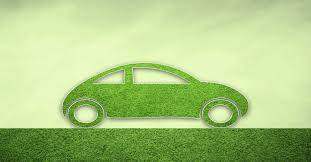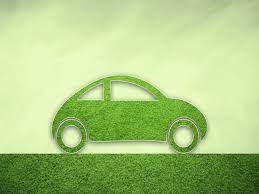Courtesy : en.wikipedia.org
Green e-vehicle
A green vehicle, clean vehicle, eco-friendly vehicle or environmentally friendly vehicle is a road motor vehicle that produces less harmful impacts to the environment than comparable conventional internal combustion engine vehicles running on gasoline or diesel, or one that uses certain alternative fuels.Presently, in some countries the term is used for any vehicle complying or surpassing the more stringent European emission standards (such as Euro6), or California’s zero-emissions vehicle standards (such as ZEV, ULEV, SULEV, PZEV), or the low-carbon fuel standards enacted in several countries.
Green vehicles can be powered by alternative fuels and advanced vehicle technologies and include hybrid electric vehicles, plug-in hybrid electric vehicles, battery electric vehicles, compressed-air vehicles, hydrogen and fuel-cell vehicles, neat ethanol vehicles, flexible-fuel vehicles, natural gas vehicles, clean diesel vehicles, and some sources also include vehicles using blends of biodiesel and ethanol fuel or gasohol.In 2021, with an EPA-rated fuel economy of 142 miles per gallon gasoline equivalent (mpg-e) (1.7 L/100 km), the 2021 Tesla Model 3 Standard Range Plus RWD became the most efficient EPA-certified vehicle considering all fuels and all years, surpassing the 2020 Tesla Model 3 Standard Range Plus and 2019 Hyundai Ioniq Electric.
Several authors also include conventional motor vehicles with high fuel economy, as they consider that increasing fuel economy is the most cost-effective way to improve energy efficiency and reduce carbon emissions in the transport sector in the short run. As part of their contribution to sustainable transport, these vehicles reduce air pollution and greenhouse gas emissions, and contribute to energy independence by reducing oil imports.
An environmental analysis extends beyond just the operating efficiency and emissions. A life-cycle assessment involves production and post-use considerations. A cradle-to-cradle design is more important than a focus on a single factor such as energy efficiency.
Energy efficiency
Main article: Energy efficiency in transport
Cars with similar production of energy costs can obtain, during the life of the car (operational phase), large reductions in energy costs through several measures:
Types
Comparison of energy efficiency between battery and hydrogen fuel-cell cars


Sales of both the Chevrolet Volt plug-in hybrid (top) and the Nissan Leaf all-electric car (bottom) began in December 2010.
PSA Peugeot Citroën Hybrid Air concept exhibited at the 2013 Geneva Motor Show
Further information: Alternative fuel vehicle
Green vehicles include vehicles types that function fully or partly on alternative energy sources other than fossil fuel or less carbon-intensive than gasoline or diesel.
Another option is the use of alternative fuel composition in conventional fossil fuel-based vehicles, making them function partially on renewable energy sources. Other approaches include personal rapid transit, a public transportation concept that offers automated, on-demand, non-stop transportation on a network of specially built guideways.
Electric and fuel cell-powered
See also: Electric vehicle and Plug-in hybrid
Examples of vehicles with reduced petroleum consumption include electric cars, plug-in hybrids and fuel cell-powered hydrogen cars.
Electric cars are typically more efficient than fuel cell-powered vehicles on a Tank-to-wheel basis. They have better fuel economy than conventional internal combustion engine vehicles but are hampered by range or maximum distance attainable before discharging the battery. The electric car batteries are their main cost. They provide a 0% to 99.9% reduction in CO2 emissions compared to an ICE (gasoline, diesel) vehicle, depending on the source of electricity.
Hybrid electric vehicles
See also: Hybrid vehicle
Hybrid cars may be partly fossil fuel (or biofuel) powered and partly electric or hydrogen-powered. Most combine an internal combustion engine with an electric engine, though other variations too exist. The internal combustion engine is often either a gasoline or Diesel engine (in rare cases a Stirling engine may even be usedThey are more expensive to purchase but cost redemption is achieved in a period of about 5 years due to better fuel economy.[
Compressed air cars, stirling vehicles, and others
See also: Compressed-air vehicle and Compressed air car
Compressed air cars, stirling-powered vehicles, Liquid nitrogen vehicles are even less polluting than electrical vehicles, as the vehicle and its components can be made more environmentally friendly.
Solar car races are held on a regular basis in order to promote green vehicles and other “green technology”. These sleek driver-only vehicles can travel long distances at highway speeds using only the electricity generated instantaneously from the sun.
Improving conventional cars
The Fiat Siena Tetrafuel 1.4 is a multifuel car designed to run as a flex-fuel on gasoline, or E20–E25 blend, or neat ethanol (E100); or to run as a bi-fuel with natural gas (CNG).
Main articles: Biofuel, compressed natural gas, and clean diesel
See also: Volkswagen emissions scandal
A conventional vehicle can become a greener vehicle by mixing in renewable fuels or using less carbon intensive fossil fuel. Typical gasoline-powered cars can tolerate up to 10% ethanol. Brazil manufactured cars that run on neat ethanol, though there were discontinued. Another available option is a flexible-fuel vehicle which allows any blend of gasoline and ethanol, up to 85% in North America and Europe, and up to 100% in Brazil.] Another existing option is to convert a conventional gasoline-powered to allow the alternative use of CNG. Pakistan, Argentina, Brazil, Iran, India, Italy, and China have the largest fleets of natural gas vehicles in the world.
Diesel-powered vehicles can often transition completely to biodiesel, though the fuel is a very strong solvent, which can occasionally damage rubber seals in vehicles built before 1994. More commonly, however, biodiesel causes problems simply because it removes all of the built-up residue in an engine, clogging filters, unless care is taken when switching from dirty fossil-fuel derived diesel to bio-diesel. It is very effective at ‘de-coking’ the diesel engines combustion chambers and keeping them clean. Biodiesel is the lowest emission fuel available for diesel engines. Diesel engines are the most efficient car internal combustion engines. Biodiesel is the only fuel allowed in some North American national parks because spillages will completely bio-degrade within 21 days. Biodiesel and vegetable oil fuelled, diesel engined vehicles have been declared amongst the greenest in the US Tour de Sol competition.
This presents problems, as biofuels can use food resources in order to provide mechanical energy for vehicles. Many experts point to this as a reason for growing food prices, particularly US Bio-ethanol fuel production which has affected maize prices. In order to have a low environmental impact, biofuels should be made only from waste products, or from new sources like algae.
Electric Motor and Pedal Powered Vehicles
Multiple companies are offering and developing two, three, and four wheel vehicles combining the characteristics of a bicycle with electric motors. US Federal, State and Local laws do not clearly nor consistently classify these vehicles as bicycles, electric bicycles, motorcycles, electric motorcycles, mopeds, Neighborhood Electric Vehicle, motorised quadricycle or as a car. Some laws have limits on top speeds, power of the motors, range, etc. while others do not.
Other
Further information: Personal rapid transit
Solar vehicle
- Public transportation vehicles are not usually included in the green vehicle category, but Personal rapid transit (PRT) vehicles probably should be. All vehicles that are powered from the track have the advantage of potentially being able to use any source of electric energy, including sustainable ones, rather than requiring liquid fuels. They can also switch regenerative braking energy between vehicles and the electric grid rather than requiring energy storage on the vehicles. Also, they can potentially use the entire track area for solar collectors, not just the vehicle surface. The potential PRT energy efficiency is much higher than that which traditional automobiles can attain.
- Solar vehicles are electric vehicles powered by solar energy obtained from solar panels on the surface (generally, the roof) of the vehicle. Photovoltaic (PV) cells convert the Sun’s energy directly into electrical energy. Solar vehicles are not practical day-to-day transportation devices at present, but are primarily demonstration vehicles and engineering exercises, often sponsored by government agencies. However, some cities have begun offering solar-powered buses, including the Tindo in Adelaide, Australia.
- Wind-powered electric vehicles primarily use wind-turbines installed at a strategic point of the vehicle, which are then converted into electric energy which causes the vehicle to propel.





